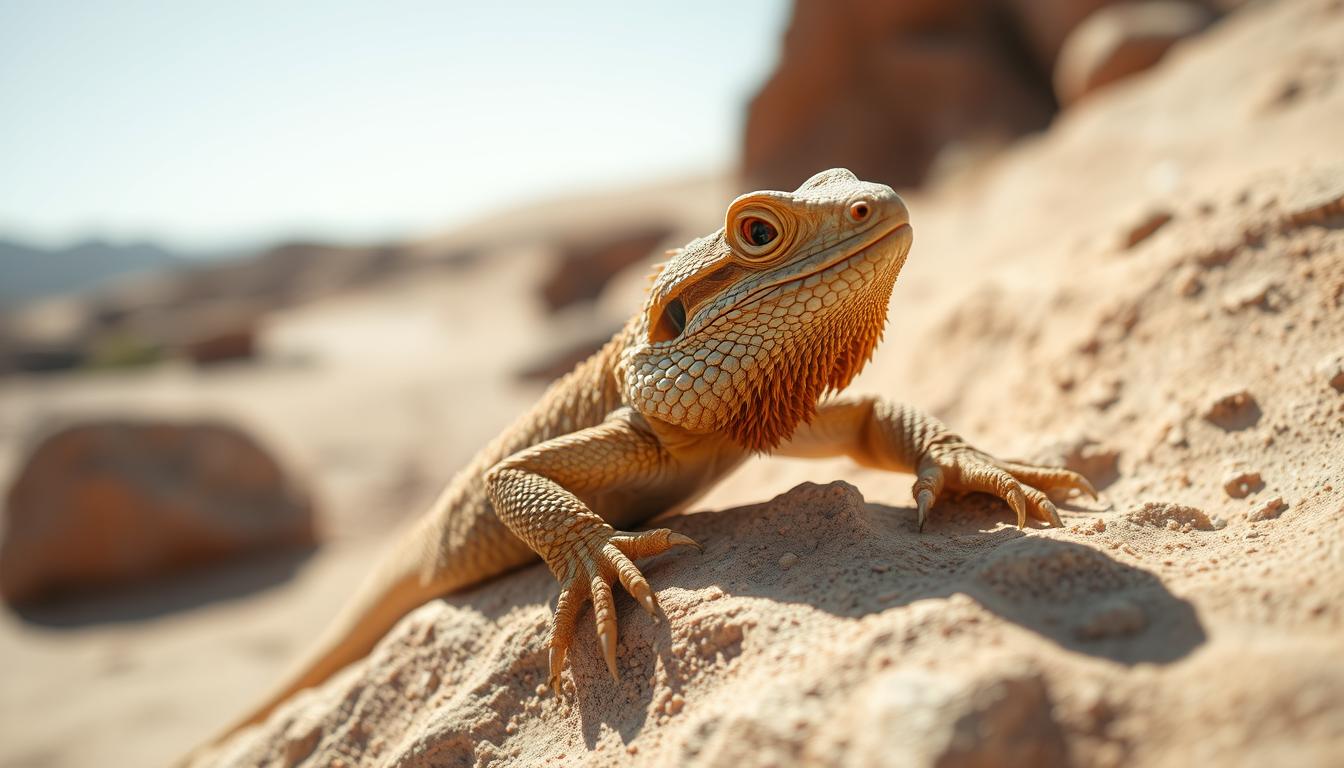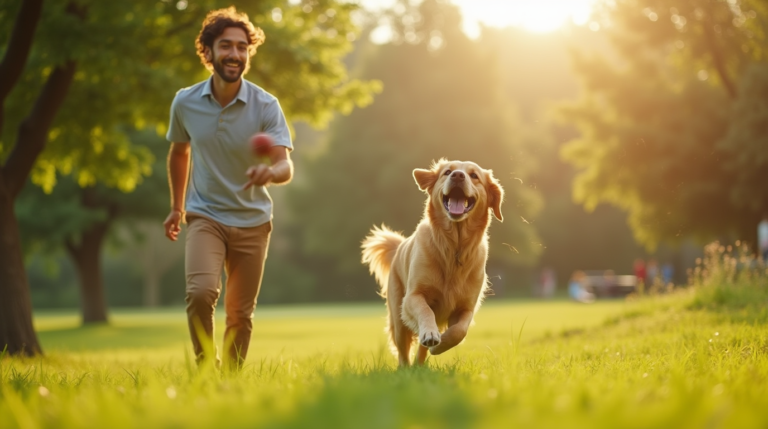If you’re new to owning a bearded dragon, you might worry about bites. These pets are usually calm and friendly. But, they might bite if they’re hungry, scared, or not used to being handled.
Knowing why they bite and how to stop it is important. It helps keep you and your pet safe and happy together.
Table of Contents
Introduction: Understanding Bearded Dragon Biting Behavior
Bearded dragons are popular pets known for their calm nature. However, their biting behavior can worry owners. Knowing what causes these bites is key to a safe and happy pet experience.
Overview of Bearded Dragons as Pets
Bearded dragons come from Australia and are loved as pets. They grow up to 24 inches long and can live 15 years with good care. Their size and gentle nature make them great pets.
Factors that Influence Biting Tendencies
- Stress levels: Bearded dragons may bite if they feel threatened or stressed. This is a natural defense.
- Environmental conditions: Things like temperature and humidity can affect their stress. This can lead to biting.
- Socialization and handling: Bearded dragons that aren’t socialized may bite more. This is because they don’t trust their owners.
- Feeding: Bearded dragons might bite accidentally when they think food is on their owner’s fingers.
- Hormonal changes: During breeding season or when coming out of brumation, bearded dragons can be more aggressive. This includes biting.
Knowing these factors helps owners create a safe space for their bearded dragons. This reduces the chance of bites and builds a strong bond between pet and owner.
Reasons Why Bearded Dragons Bite
Bearded dragons are usually calm pets. But, they might bite for a few reasons. Knowing these can help you avoid and handle bites better.
Hunger and Mistaking Fingers for Food
A hungry bearded dragon might think your fingers are food. This is common in young dragons with sharp teeth. Feeding them well and in the right amounts can stop these bites.
Self-Defense and Feeling Threatened
Bearded dragons bite when they feel scared or stressed. This is called a “defensive bite.” It’s important to socialize and handle them gently to make them feel safe with you.
Lack of Socialization and Handling
Dragons not socialized or handled much might bite more. Building trust through gentle, regular interactions helps. This makes your pet calm and friendly.
Understanding why bearded dragons bite – hunger, self-defense, and lack of socialization – helps. You can then make a safe, happy space for you and your dragon.
Improper Handling Techniques
Proper bearded dragon handling is key to avoid bites. Move calmly, support their whole body, and avoid sudden moves. This ensures a safe and enjoyable time for both you and your pet.
Bad handling techniques can make bearded dragons bite. Holding them too tight or grabbing them can be uncomfortable. Learning the right way to handle your bearded dragon is vital for avoiding bites.
- Move slowly and calmly around your bearded dragon, letting them get used to you.
- Slide one hand under their belly to support them, and use the other to gently guide their head away from your hand.
- Don’t make sudden moves or actions that might scare or threaten them, as this can make them defensive.
- Be patient and build trust and positive feelings through regular, gentle handling.
By using proper handling techniques, you can make your bearded dragon’s environment stress-free. This reduces the chance of bites. Regular, gentle handling makes them feel safe and secure, building a strong bond between you and your pet.
How Severe is a Bearded Dragon’s Bite?
Bearded dragons are usually calm and gentle. But, their bite can still be strong. The bite’s strength depends on the dragon’s age and size. Young or small dragons bite less hard, while big adults can bite harder.
Bite Force and Potential Injuries
Bearded dragons have sharp teeth that can hurt. Their bite can cause wounds and cuts. An adult dragon’s bite is strong, but not as strong as a human’s.
Bearded dragon bites can be painful. They might cause bruises, swelling, and bleeding. It’s important to know how serious a bite can be.
Handling a Bite and First Aid
If a bearded dragon bites, stay calm. Don’t pull away, as it can make things worse. Instead, try to gently pull the dragon’s jaws off your skin.
After the bite, clean the wound with soap and water. This helps prevent infection. Use an antiseptic cream and watch for signs of infection. If the bite is severe, see a doctor.

Bearded dragon bites can be uncomfortable. But, understanding their behavior helps prevent bites. Handling them right and keeping them happy can make your time together better.
Do bearded dragons bite?
Bearded dragons are usually calm and make great pets. But, they can bite sometimes. Knowing why they might bite and how to handle them is key to avoiding bites and building a good bond with your pet.
Understanding Triggers and Preventing Bites
Bearded dragons bite for different reasons, like:
- Hunger or mistaking your fingers for food
- Feeling threatened or stressed
- Lack of proper socialization and handling
To lower the chance of a bearded dragon bite, know these reasons and act on them. Make sure your dragon eats well, keep their environment calm, and get them used to being handled slowly and gently.
Proper Socialization and Handling
Good socialization and handling help avoid bearded dragon bites. Begin by letting your dragon get used to you. Start with touch and picking them up slowly. Use treats to make handling a positive thing.
When you hold your bearded dragon, support their whole body. Don’t hold them too tight. Watch for signs of stress, like puffing out their beard or trying to get away. If you see these signs, gently put them back in their home.
By knowing why they might bite and using the right socialization and handling techniques, you can greatly lower the chance of your bearded dragon biting. This way, you both can have a safe and enjoyable time together.
Creating a Stress-Free Environment
Creating a comfy and enriching home is key for a happy, healthy bearded dragon. By setting up the right environment and meeting their natural needs, you can lower stress. This helps prevent aggressive actions, like biting.
Habitat Setup and Temperature Regulation
Bearded dragons need a temperature range in their home. The basking area should be between 95°F to 105°F. The cooler area should be around 75°F to 85°F. This helps them stay healthy and happy.
Also, make sure their home has lots of hiding spots and places to bask. Use different substrates, rocks, branches, and plants. These things make their home feel natural and safe, helping to reduce stress.
Enrichment and Hiding Spots
Bearded dragons love to explore and be active. So, it’s important to give them things to do. Add hiding spots like caves, logs, and plants. Also, include climbing structures and basking platforms to meet their climbing needs.
By making their home comfortable, safe, and engaging, you can keep your bearded dragon happy. This reduces the chance of them becoming aggressive or biting.
| Habitat Element | Recommended Specifications |
|---|---|
| Basking Area Temperature | 95°F to 105°F |
| Cool End Temperature | 75°F to 85°F |
| Hiding Spots | Multiple, varied options (caves, logs, plants) |
| Enrichment | Climbing structures, basking platforms, interactive elements |
By making their home comfortable and engaging, you can help your bearded dragon thrive. This reduces the risk of them becoming aggressive or biting.
Feeding Your Bearded Dragon Properly
It’s important to give your bearded dragon a balanced diet. They need a mix of live insects and veggies to stay healthy. This mix is key for their wellbeing.
Balanced Diet and Portion Control
Young bearded dragons should eat mostly insects, about 70%. The rest should be leafy greens and veggies. As they grow, the mix of food changes. But always watch the portions to avoid health problems.
Check your dragon’s size and age to know how much to feed. This helps keep them healthy.
Hand-Feeding Techniques
Hand-feeding can help prevent bites. It makes your dragon see you as a good source of food. Move slowly and calmly when feeding.
This builds trust and lowers the chance of biting. A happy, well-fed dragon is less likely to bite. Hand-feeding strengthens your bond and keeps your dragon healthy and happy.
Signs of Stress and Aggression
It’s key to know when your bearded dragon is stressed or aggressive. This helps avoid bites and keeps your bond strong. Bearded dragons show their feelings through body language and actions.
Body Language and Behavioral Cues
Watch how your bearded dragon looks and moves. Look out for these signs of stress or aggression:
- Head bobbing: Male bearded dragons bob their heads to show dominance or during mating.
- Arm waving: Younger or submissive dragons wave their arms to show they’re not a threat.
- Bearding: When they flare their throat skin, it means they’re stressed, scared, or aggressive.
- Tail twitching: This shows they’re agitated or excited.
- Hissing: They hiss to defend themselves, which might lead to biting or tail whipping.
- Glass surfing: Running along the enclosure’s sides can mean they’re stressed, bored, or want to explore.
Responding to Stress Signals
If you see these stress signs, stay calm and act right. Don’t handle them if they’re aggressive. Instead, give them a quiet, safe space. Slowly introduce them to good experiences and socialization to reduce aggression.

Knowing your bearded dragon’s body language helps you meet their needs. This makes for a happy and peaceful relationship.
Bearded Dragon Temperament and Sociability
Bearded dragons are known for being calm and friendly. They make great pets for those who spend time with them. With the right care, they can bond strongly with their owners, even recognizing them.
But, each bearded dragon is different. Some are very friendly, while others might be shy or not like being handled. It’s key to know your dragon’s likes and limits to keep them happy and stress-free.
| Characteristic | Description |
|---|---|
| Friendly Bearded Dragons | Bearded dragons that are well-socialized and accustomed to human interaction often become quite tame and enjoy spending time with their owners. They may even recognize their caretakers and respond to their presence. |
| Skittish Bearded Dragons | Some bearded dragons may be more shy or nervous, particularly if they haven’t been handled regularly or were exposed to stressful situations in the past. These individuals may require a more gradual and patient approach to handling and socialization. |
| Adaptable Personalities | With time, patience, and consistent positive reinforcement, even initially skittish bearded dragons can become more comfortable and develop a stronger bond with their owners. The key is to respect their individual needs and preferences. |
The care and attention you give your bearded dragon greatly affects their temperament and sociability. By understanding their unique personalities and creating a stress-free environment, you can build a rewarding relationship with your pet.
Conclusion
In conclusion, bearded dragons rarely bite if they are well cared for and socialized. Knowing why they might bite helps prevent it. This includes hunger, stress, and not being handled enough.
Creating a stress-free home, feeding them right, and handling them gently are key. These steps help avoid bites and make your bond with your bearded dragon strong.
Watching your bearded dragon’s signs and keeping their home safe and fun is important. Also, don’t overfeed them. If a bite happens, take your hand out, clean the wound, and watch for any signs of trouble.
By fixing the reasons behind bites and following bearded dragon care tips, you can avoid bites. This way, you and your bearded dragon can have a great time together.
With the right understanding of bearded dragon behavior, patience, and a caring home, you can create a strong bond. This bond will be free from bites, making your time together both rewarding and fun.
FAQ
Do bearded dragons bite?
What are the reasons for a bearded dragon biting?
How severe can a bearded dragon’s bite be?
How can I prevent my bearded dragon from biting?
What is the typical temperament of a bearded dragon?
Source Links
- 2024 Bearded Dragon Care Tips for New Owners – https://www.liveoakvet.com/bearded-dragon-care/
- Bearded Dragon – BeWild Reptile Rescue – https://bewildnc.org/bearded-dragon/
- Bites: Signs, Causes and Prevention with Bearded Dragons – https://beardeddragonsworld.com/bearded-dragon-bites/
- Taming a Bearded Dragon & Bite Prevention: Ultimate Guide – https://beardeddragonsworld.com/taming-a-bearded-dragon/
- 7 Facts on How To Deal With Bearded Dragons – https://medium.com/@animalsaroundtheglobeofficial/7-facts-on-how-to-deal-with-bearded-dragons-ba18461e1bad
- Do Bearded Dragons Bite? Understanding Their Behavior and Care – Frog Family Reptile – https://www.frogfamilyreptile.com/bearded-dragon/behavior/do-bearded-dragons-bite/
- Do Bearded Dragons Bite? Reasons & How Much It Hurts | Hepper – https://www.hepper.com/do-bearded-dragons-bite/
- Bearded dragon Bite is Dangerous? – https://medium.com/@bearddragon123456789/bearded-dragon-bite-is-dangerous-77249886fcc2
- Does a Bearded Dragon’s Bite Hurt? Reasons for Biting & Facts | Hepper – https://www.hepper.com/does-a-bearded-dragons-bite-hurt/
- 3 Types of Family Pets That Could Make You Sick – https://www.parents.com/family-pets-that-could-make-you-sick-8665303
- Bearded Dragon Care Sheet – https://www.petmd.com/reptile/bearded-dragon-care-sheet
- What to Know About Bearded Dragons – https://www.webmd.com/pets/what-to-know-about-bearded-dragons
- The bearded dragon shows a lack of response to stimuli. – VetBilim – https://vetbilim.com/en/blog/article/lack-of-response-in-bearded-dragons-causes-and-assistance/
- Bearded Dragon Rubbing Face On Ground – Common Reasons – https://www.reptileguided.com/bearded-dragon-rubbing-face-on-ground/
- How to Stop a Bearded Dragon from Biting: Quick Tips for Taming Your Scaly Friend – Frog Family Reptile – https://www.frogfamilyreptile.com/bearded-dragon/how-to-stop-a-bearded-dragon-from-biting/
- Understanding Bearded Dragon Behavior | Blog | Long Island Bird and Exotics Pet Vet – https://www.birdexoticsvet.com/post/understanding-bearded-dragon-behavior
- Suddenly Aggressive Bearded Dragon: Signs, Reasons & Fixes – https://beardeddragonsworld.com/aggressive-bearded-dragon/
- Bearded Dragon Care: Keeping Your Dragon Happy | Red Bluff Animal Hospital – https://redbluffanimalhospital.com/2024/07/15/bearded-dragon-care-keeping-your-dragon-happy/
- How To Care For Your Bearded Dragon | RSPCA – RSPCA – rspca.org.uk – https://www.rspca.org.uk/adviceandwelfare/pets/other/beardeddragon
- Do Bearded Dragons Bite? Understanding Bearded Dragon Behavior and Safety – Pets River – https://petsriver.com/do-bearded-dragons-bite/







